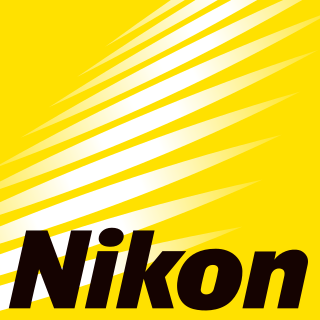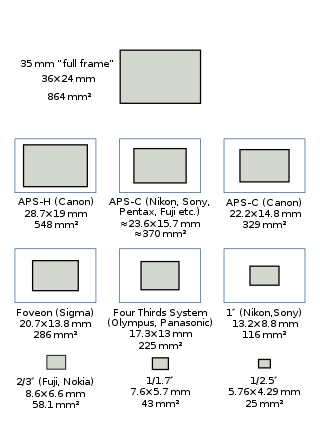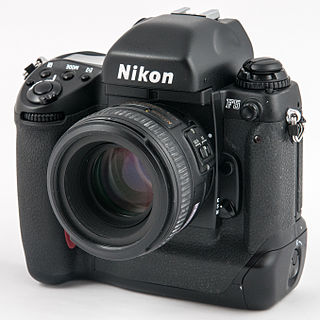
A digital camera, also called a digicam, is a camera that captures photographs in digital memory. Most cameras produced today are digital, largely replacing those that capture images on photographic film or film stock. Digital cameras are now widely incorporated into mobile devices like smartphones with the same or more capabilities and features of dedicated cameras. High-end, high-definition dedicated cameras are still commonly used by professionals and those who desire to take higher-quality photographs.

Advanced Photo System (APS) is a discontinued film format for still photography first produced in 1996. It was marketed by Eastman Kodak under the brand name Advantix, by FujiFilm under the name Nexia, by Agfa under the name Futura and by Konica as Centuria.

The Nikon D70 is a digital single-lens reflex camera, introduced at the 2004 PMA Annual Convention and Trade Show, as Nikon's first consumer-level digital SLR, and a competitor to the Canon EOS 300D. It was often sold in a "kit package" with the Nikon 18-70mm AF-S lens. The Nikon D70 was succeeded initially by the Nikon D70s and eventually by the Nikon D80 and Nikon D90, announced on August 9, 2006 and August 27, 2008 respectively. The Nikon D70 is the first DSLR camera built by Nikon's factory in Thailand. It debuted at a price of US$999.

Nikon Corporation is a Japanese optics and photographic equipment manufacturer. Nikon's products include cameras, camera lenses, binoculars, microscopes, ophthalmic lenses, measurement instruments, rifle scopes, spotting scopes, and equipment related to semiconductor fabrication, such as steppers used in the photolithography steps of such manufacturing. Nikon is the world's second largest manufacturer of such equipment.

A digital single-lens reflex camera is a digital camera that combines the optics and mechanisms of a single-lens reflex camera with a solid-state image sensor and digitally records the images from the sensor.

The NikonD50 is a 6.1-megapixel entry-level digital single-lens reflex camera, sold from June 2005 until November 2006 by Nikon. It was Nikon's first DSLR aimed at the consumer market, and sold for US$899. It uses the Nikon F mount. The D50 is similar to the slightly older D70 using the same CCD sensor, with a slower maximum shutter speed and slightly smaller size. However, it continued to offer the internal focus motor of prior autofocus film and digital SLRs; making it suitable for the use of autofocus with late film-era Nikkor AF and AF-D lenses. Future entry-level Nikon DSLRs would eliminate the internal focus motor and require these motors to be in the lenses.

Advanced Photo System type-C (APS-C) is an image sensor format approximately equivalent in size to the Advanced Photo System film negative in its C ("Classic") format, of 25.1×16.7 mm, an aspect ratio of 3:2 and Ø 30.15 mm field diameter. It is therefore also equivalent in size to the Super 35 motion picture film format, which has the dimensions of 24.89 mm × 18.66 mm and Ø 31.11 mm field diameter.

The Nikon D1 is a digital single-lens reflex camera (DSLR) that was made by Nikon Corporation introduced on June 15, 1999. It features a 2.7-megapixel image sensor, 4.5-frames-per-second continuous shooting, and accepts the full range of Nikon F-mount lenses. The camera body strongly resembles the F5 and has the same general layout of controls, allowing users of Nikon film SLR cameras to quickly become proficient in using the camera. Autofocus speed on the D1 series bodies is extremely fast, even with "screw-driven" AF lenses.

The Nikon F-mount is a type of interchangeable lens mount developed by Nikon for its 35mm format single-lens reflex cameras. The F-mount was first introduced on the Nikon F camera in 1959, and features a three-lug bayonet mount with a 44 mm throat and a flange to focal plane distance of 46.5 mm. The company continues, with the 2020 D6 model, to use variations of the same lens mount specification for its film and digital SLR cameras.

A full-frame DSLR is a digital single-lens reflex camera (DSLR) with a 35 mm image sensor format. Historically, 35 mm was one of the standard film formats, alongside larger ones, such as medium format and large format. The full-frame DSLR is in contrast to full-frame mirrorless interchangeable-lens cameras, and DSLR and mirrorless cameras with smaller sensors, much smaller than a full 35 mm frame. Many digital cameras, both compact and SLR models, use a smaller-than-35 mm frame as it is easier and cheaper to manufacture imaging sensors at a smaller size. Historically, the earliest digital SLR models, such as the Nikon NASA F4 or Kodak DCS 100, also used a smaller sensor.

The Kodak Professional Digital Camera System or DCS, later unofficially named DCS 100, was the first commercially available digital single-lens reflex (DSLR) camera. It was a customized camera back bearing the digital image sensor, mounted on a Nikon F3 body and released by Kodak in May 1991; the company had previously shown the camera at Photokina in 1990. Aimed at the photo journalism market in order to improve the speed with which photographs could be transmitted back to the studio or newsroom, the DCS had a resolution of 1.3 megapixels. The DCS 100 was publicly presented for the first time in Arles (France), at the Journées de l'Image Pro by Mr Ray H. DeMoulin, the worldwide President of the Eastman Kodak Company. 453 international journalists attended this presentation, which took place in the Palais des Congres of Arles.

The Nikon F5 is a professional 35 mm film-based single-lens reflex camera body manufactured by Nikon from 1996 through 2004. It was the fifth in Nikon's professional film camera line, which began in 1959 with the Nikon F. It followed the Nikon F4 of 1988, which introduced in-body autofocus to Nikon's professional line. The F5 was in turn succeeded by the Nikon F6, as well as Nikon's parallel range of professional digital SLRs, beginning with the Nikon D1.

The Nikon D40 is a 6.1-megapixel DX format DSLR Nikon F-mount camera announced by Nikon on November 16, 2006. It replaces the D50 as Nikon's entry level DSLR. It features a 2.5-inch 230,000-dot resolution LCD monitor, CCD sensor with ISO 200-1600 and 3D Color Matrix Metering.

The Nikon D3 is a 12.0-megapixel professional-grade full frame (35 mm) digital single lens reflex camera (DSLR) announced by the Nikon Corporation on 23 August 2007 along with the Nikon D300 DX format camera. It was Nikon's first full-frame DSLR. The D3, along with the Nikon D3X, was a flagship model in Nikon's line of DSLRs, superseding the D2Hs and D2Xs. It was replaced by the D3S as Nikon's flagship DSLR. The D3, D3X, D3S, D4, D4s, D5, D6, D700, D800, D800Е and Df are the only Nikon FX format DSLRs manufactured in Japan. The D3S was replaced by the D4 in 2012.

The Kodak Digital Camera System is a series of digital single-lens reflex cameras and digital camera backs that were released by Kodak in the 1990s and 2000s, and discontinued in 2005. They are all based on existing 35mm film SLRs from Nikon, Canon and Sigma. The range includes the original Kodak DCS, the first commercially available digital SLR.

The Canon EOS DCS 3 was Kodak's second Canon based Digital SLR camera released in July 1995, four months after Kodak EOS-DCS 5. It uses a modified Canon EOS-1N film camera with a modified Kodak NC2000e digital camera back attached. As a result, it maintained the Canon EF lens mount, and full compatibility with all of Canon's EF lenses made until that time. The camera was followed by the six megapixel Canon EOS DCS 1, which was released later in December 1995.

The Nikon E series, co-developed with Fujifilm, are autofocus 1.3 megapixel professional grade quasi-full frame (35mm) Nikon F-mount digital single lens reflex cameras (DSLR) manufactured by Nikon since 1995.

The Nikon D3000 is a 10.2-megapixel DX format DSLR Nikon F-mount camera announced by Nikon on 30 July 2009. It replaces the D40 as Nikon's entry level DSLR. It features a 3.0-inch 230,000-dot resolution LCD monitor, CCD sensor with ISO 100–1600 and 3D tracking Multi-CAM1000 11-point AF system which makes it quite similar to the Nikon D200 in these main parts. Initially priced with $599 MSRP, actual prices are much lower.

The Nikon D7000 is a 16.2-megapixel digital single-lens reflex camera (DSLR) model announced by Nikon on September 15, 2010. It replaced the D90 as the top end consumer camera, by using much of the technology and controls from the earlier D5000, in a larger more robust body similar to the flagship D300 series. In some ways it was superior to the D300S, though for several years the two cameras were both available with the D300 positioned as the flagship in Nikon marketing materials.

The Nikon D7500 is a 20.9-megapixel digital single-lens reflex camera using an APS-C sensor. It was announced by Nikon Corporation on 12 April 2017, and started shipping on 2 June 2017. It is the successor to the Nikon D7200 as Nikon's DX format midrange DSLR.

























